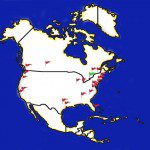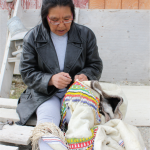APTN Is Breaking Big with a Small Team of Dedicated Journalists
Reporters at the Aboriginal Peoples Television Network toiled in obscurity—until they scooped the big guys on the Bruce Carson scandal
A box full of private emails, handed over at a gas station across from Collins Bay Penitentiary in Kingston, helped change what Canadian journalists think of the Aboriginal Peoples Television Network news and current affairs division. APTN National News, which first went on air in 2002, positions itself as an alternative to mainstream broadcast news and has a target audience of First Nations, Inuit and Métis. Later, the network added two other news shows—APTN Investigates and APTN InFocus—but continued to broadcast in relative obscurity. As it turns out, though, that was a major advantage because it helped APTN Investigates break the Bruce Carson scandal, which started with that box of emails. And thanks to that story, more people, viewers and journalists alike, are taking notice of APTN news.
Freelance journalist Kenneth Jackson received a tip about the box because of his previous investigations intounderage prostitution. The private emails were from Carson, head of the Canada School of Energy and Environment and a former top advisor to Prime Minister Stephen Harper. Jackson organized the emails by date and uncovered the beginnings of a story involving the Prime Minister’s Office (PMO), an escort service, a water purification company, First Nations communities and alleged illegal lobbying by Carson.
Jackson took the story to his friend and APTN reporter, Jorge Barrera. Working for APTN Investigates, the two approached Carson and H2O Pros, the water company involved, after aboutthree weeks of research. If they had been with a more recognizable brand, such as the fifth estate or The Globe and Mail, the company would have wanted to know, “‘Why the hell are you here?’” says Jackson. “They’re going to get their back up right away.” About 10 minutes after he and Barrera emailed their request, the company agreed to the interview and offered to bring Carson. Whether H2O Pros believed it was getting free publicity or not, it underestimated APTN Investigates.
The scoop showed that the network was capable of handling high profile news and breaking big stories. “It means in some ways we’re leading now,” says Paul Barnsley, executive producer of APTN Investigates and APTN InFocus. “We’re getting a lot more respect.”
Of course, APTN National News had broken stories before—it just didn’t generate as much attention. For example, Barrera convinced WikiLeaks to give APTN about 800 diplomatic cables from the U.S. embassy and consulates in Canada. This was part of the 250,000 U.S. State Department cables from around the globe distributed by the whistleblower website to select media organizations worldwide. To obtain the cables, Barrera used old-fashioned persistence and modern social media. He first messaged a WikiLeaks contact over Facebook in early December 2010, heard back in February and then, in late April, received confirmation that he’d be getting cables classified as secret or confidential. Even though the cables do not specifically relate to aboriginal issues, APTN has rolled out 18 WikiLeaks stories since then. CBC was the only other Canadian news organization to receive the full batch of cables.
Still, before Carson, Barnsley heard veteran reporters working for APTN say that reporters from CBC and other outlets didn’t take them seriously and even accused APTN news of bias. But he argues the network’s focus on aboriginal-related issues is in contrast to what he sees as a mainstream bias that means journalists represent aboriginal issues unfairly or not at all.
Now, though, more journalists are pitching him stories. And APTN Investigates has a working relationship with CTV’s investigative show, W5: the two exchange information that would work better for the other. CBC investigative reporter David McKie is not surprised APTN Investigates is doing so well. He and his colleagues followed APTN’s coverage of the Carson story for months because it was so credible and because the amount of work APTN journalists put into it was obvious.
Despite the success of the story, Barnsley does have some regrets. APTN Investigates went to the PMO too early, allowing Ottawa to preemptively act and address the evidence. The story was meant to air on March 25, 2011, but the third interview with Carson, when Jackson and Barrera cornered him, was on March 13. Within 48 hours, APTN Investigates invited the PMO to look at the documentation it possessed. Later that week, the PMO publicly released letters calling for three investigations, one of them by the RCMP, into the Carson case. By March 18, the story was out.
Other major news organizations launched their own investigations. To be the first to cover the story, APTN National News reported only a few lines in the evening broadcast, and then posted an online article. The next day, APTN Investigates ran a three- or four-minute piece, following up for the next few days until the entire story aired on APTN Investigates. McKie says the way APTN handled the situation showed sophistication.
With lessons learned, APTN National News still faces the challenge of reaching Canada’s vast array of aboriginal communities. There are nine bureaus across the country, but a lot of communities are in remote locations. Geography makes it difficult to cover breaking news in real time and Barrera likens APTN’s reporters to domestic foreign correspondents.
APTN’s viewers want to see more breaking news on the channel in between newscasts and not just on the website because many aboriginal communities have easier access to television than the internet. Henry Naulaq, a producer for the Inuit Broadcasting Corporation in Iqaluit, wants the network to broadcast more local community meetings and special events such as the governor general’s visit to Nunavut. And Pamela Palmater, a lawyer, professor and chair of Ryerson University’s Centre for Indigenous Governance, wants to see investigations that are longer than half an hour and says, “The people that I’m associated with in the legal and political realm rely on APTN more and more.”
APTN National News is not that visually polished, but what it lacks in gloss, it makes up for in talent. The investigative team gave Jackson and Barrera space to work: “Obviously they had questions for us, but that’s a real good sign of a news organization that knows what they’re doing,” says Jackson. “You don’t micromanage reporters.” He stresses that Barnsley and APTN Investigates supported them, even when “shit hit the fan” and lawyers got involved.
Barnsley’s goal is to shine a light on the questionable practices in aboriginal communities that everyone knows about, but isn’t willing to speak about. His advice: “If journalists are the type that want everybody to be their friend, then they’re really not very good. They’re probably not ever going to be very good.” That attitude should keep APTN breaking big stories—and from fading into obscurity again.














